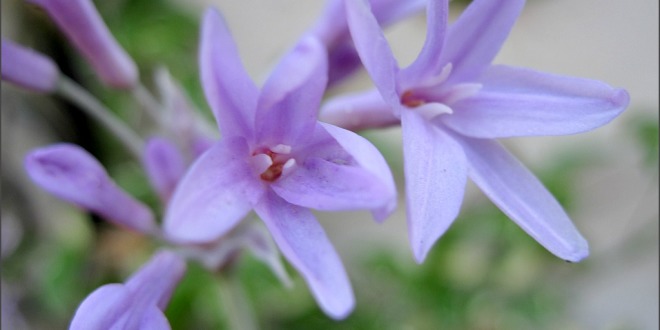Society garlic is an attractive ornamental plant from South Africa whose leaves have a garlicky odor. It belongs to the lily family — as do onions and garlic — but to a different genus, entirely restricted to Africa, which includes about 24 species. The genus name Tulbaghia honors Ryk Tulbagh, an 18th-century Dutch governor of the Cape of Good Hope; the species name violacea refers to the flower color, variously described as lilac, lilac-blue, pink, purplish-violet or violet. The common name, society garlic, presumably refers to the plant’s clump-forming habit and garlic-smelling leaves. The blossoms lack the pungent odor; those of a related species, T. fragrans, are described as sweetly scented.
Each plant has only five or six leaves 1 foot long by 1/4 inch wide arising from a bulb, and doesn’t make much of a splash. However, a clump of individuals gives the effect of a much larger plant. The leaves of the species are grayish-green, but the cultivar ‘Silver Lace’ has green leaves edged with white, and ‘Tricolor’ has leaves striped with pink, white and green. A leafless stalk 1 or 2 feet tall holds seven to 20 flowers above the foliage in an umbel. The flowers are much showier than those of regular garlic. The blooms are urn-shaped, about 3/4 inch long. Six petals, each about 3/8 inch long, flare out from the top of the “urn,” and six tiny scales form a corona within its throat.
In the herb garden, society garlic looks attractive with plants of contrasting foliage and habit. Any of the creeping or shrubby thymes (Thymus spp.) would complement it, as would the fine gray foliage and tiny yellow flowers of lavender cotton (Santolina chamaecyparissus). One of the purple-leaved basils or dark-green-leaved prostrate rosemary would form contrasts of another sort.
Details
Family: Alliaceae
Genus: Tulbaghia (tul-BAG-ee-uh) (Info)
Species: violacea (vy-oh-LAH-see-uh) (Info)
Category:
Bulbs
Height:
6-12 in. (15-30 cm)
12-18 in. (30-45 cm)
18-24 in. (45-60 cm)
Spacing:
3-6 in. (7-15 cm)
Hardiness:
USDA Zone 7a: to -17.7 °C (0 °F)
USDA Zone 7b: to -14.9 °C (5 °F)
USDA Zone 8a: to -12.2 °C (10 °F)
USDA Zone 8b: to -9.4 °C (15 °F)
USDA Zone 9a: to -6.6 °C (20 °F)
USDA Zone 9b: to -3.8 °C (25 °F)
USDA Zone 10a: to -1.1 °C (30 °F)
USDA Zone 10b: to 1.7 °C (35 °F)
Sun Exposure:
Full Sun
Danger:
N/A
Bloom Color:
Purple
Bloom Time:
Mid Spring
Late Spring/Early Summer
Foliage:
Herbaceous
Chartreuse/Yellow
Smooth-Textured
Other details:
Flowers are fragrant
Average Water Needs; Water regularly; do not overwater
Soil pH requirements:
6.6 to 7.5 (neutral)
Patent Information:
Non-patented
Propagation Methods:
By dividing rhizomes, tubers, corms or bulbs (including offsets)
Seed Collecting:
Allow pods to dry on plant; break open to collect seeds
Read more: http://davesgarden.com/guides/pf/go/487/#ixzz3Gintsn8y








